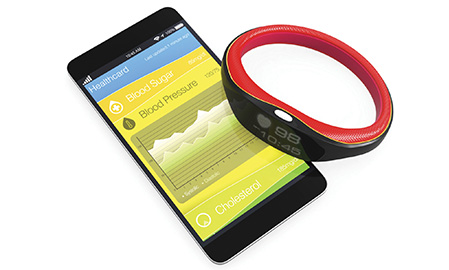Regulators, insurers and care providers are shifting to a patient-centered approach that engages patients as active participants in their own care management. Concurrently, design breakthroughs, technology advances and mass adoption of mobile consumer devices have made consumer-centric care possible in ways that were previously impossible.
Consumer electronics companies have taken note. The result? The rise of a young but very dynamic market for connected health and wellness devices that help care providers better engage their patients as well as assist consumers with their self-care needs.
Parks Associates’ consumer research found that the adoption rate for connected health devices in general has crept up 3% over the last year. These devices include traditional home medical monitoring devices (such as blood pressure monitors/glucometers) and new emerging fitness bands that can track fitness progress digitally, using smartphone apps to view and share fitness and wellness data.
13%
29%
27%
of US broadband households would like to have a personalized plan to guide them through their journey to better health
Source: Parks Assoc. Consumer Research 2014
Parks Associates data shows the following adoption and usage/interest trends:
• In the first quarter of 2013, 24% of US broadband households owned and used at least one connected health device. As of the second quarter of 2014, 27% reported owning and using a connected health device.
• Exercise equipment that has built-in app support is the most commonly owned device type; digital pedometers are a distant second.
• About one in five US consumers have started to use devices that track their health status and one in four have used health apps, according to Parks Associates’ survey data from early 2014.
• 13% of US broadband households are “very likely” to purchase a connected health device over the next 12 months.
• 29% of mobile phone users with health problems would try an easy-to-use device to track their health condition and progress towards goals.
• 27% of US broadband households would like to have a personalized plan to guide them through their journey to better health.
The burgeoning smart-watch market could also be a boon for personal health management. Many such watches have embedded sensors to track activities or have the ability to view and share health/fitness data from smartphone-compatible apps that connect to a diverse range of connected health gadgets.
This young industry got a boost when major innovators—Apple, Google and Samsung—launched their respective efforts in the connected health industry. While smart watches currently have only 3% adoption among US broadband households, Parks Associates expects that sales for these devices will exceed sales for standalone fitness bands in the long term.
Additionally, Parks Associates posits that consumers now want to play a larger role in understanding and managing their health and wellness. However, they cannot realize that desire simply by purchasing a smart watch or a connected health or fitness device.
For consumers who really want to achieve health benefits, they need to find their motivation (no matter if it is internally generated or externally incented), to use these devices consistently and then to leverage the gained knowledge to guide their behavioral changes. Consumer satisfaction with and motivation to upgrade or replace their health devices rest with how effectively these gadgets help them to accomplish their health and fitness goals.
For this reason, the applications and services that are built for these wearable gadgets will be just as important as attractive hardware features and easy-to-use user interfaces in driving the long-term success of this market. Applications and services provide personal care support in the form of easy access to information, anytime/anywhere communications with friends and care providers, interactive experiences with health and wellness services, and convenient analytical tools that use health and wellness data to spur motivation. Healthcare providers’ outreach programs and digital coaching services, coupled with loyalty programs and incentive schemes, can be delivered on these devices to reinforce and sustain both consumer interest and behavioral changes.
The integration of applications and services into health and fitness wearables ranks as the primary challenge to the industry, as it has never been done successfully before. Even though the tech business is eager to push towards this goal, the healthcare industry may be less enthusiastic or offer a different timetable. There’s also the possibility that technology companies will find the healthcare industry too fragmented, heavily regulated and traditional in its thinking. These are the greatest barriers to innovation, especially in the consumer health market.
To overcome such barriers, technology providers must make sure that they adapt to the needs of healthcare providers and insurers and build partnerships to embed the technology seamlessly into their work flow or business activities. Such collaborations have already taken place. For instance, Apple is working with Mayo Clinic and Kaiser Permanente, while Samsung is partnering with University of California at San Francisco and Cigna. These partnerships will not only make the technology more healthcare-friendly, but also secure the buy-in from these healthcare entities so that they may become a distribution channel for connected health devices.
Additional ways that wearable brands can better differentiate themselves in this increasingly competitive market include the following:
• Standardize measurements of wellness metrics and simplify personal care management process
• Enrich user experience by tracking other elements of healthy living and offering a comprehensive view of a consumer’s health and wellness status
• Introduce personal care management and coaching services to deepen user engagement and demonstrate value
Ultimately, Parks Associates believes wearables that target health and fitness use cases have great potential to transform consumer health behaviors and impact the healthcare industry in a positive way. Their long-term market success hinges on their ability to offer concrete benefits to customers buying these devices or organizations financing the purchases.
Harry Wang is the director of health & mobile product research at Parks Associates.
From the November 01, 2014 Issue of MM+M - Medical Marketing and Media







